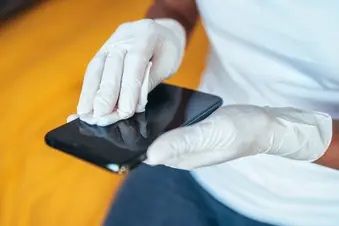
To keep your home clean, you need to think in germ terms. Sometimes a general cleaning with a milder product will usually do the job well enough. At other times and in grimier areas, you’ll need to disinfect always and often. The key is knowing which is which.
How to ID the Hotspots
It also helps to know why you’d choose one method or another. Cleaning alone will get rid of dirt and dust and reduce the number of microbes on a surface. Disinfection goes a step further: It gets rid of harmful viruses and bacteria completely. This is key when a sick person is in the home or if someone has a weakened immune system or otherwise is prone to getting sick. It requires chemicals or strong bleach solutions.
For example, items in your home that aren’t used or touched as much – think high-up areas and out-of-the-way surfaces – should be cleaned when they’re visibly dirty. For instance, you should dust ceiling fans, vacuum rugs and carpets, and wipe down sills and floorboards with soap and water as needed. These items don’t need disinfection each time you clean them.
But regardless of how deep you need to go, cleaning first is key, says Alexandra Seguin, certified infection preventionist and high consequence infectious disease lead at Rush University Medical Center in Chicago. That way, you first get rid of most of the contaminants so your disinfection gets down to the real nitty-gritty.
Zero in on High-Touch Surfaces
Disinfecting isn’t only for when someone’s sick, though. “As a rule of thumb, high-touch surfaces should be cleaned and disinfected regularly to reduce the spread of harmful bacteria, viruses, and other microbes,” Seguin says. For example, doorknobs, light switches, and other frequently used spots are prone to microbial contamination.
Other high-touch surfaces include:
- Kitchen and bathroom countertops
- Toilets, including flush handles
- Sinks
- Items used in meal prep, such as cutting boards, trash can lids, and – perhaps surprisingly – spice containers
Reach for the Right Products
So what’s the best cleaning product or method to clean and disinfect? Again, it depends.
“Soap and water would be a first step for cleaning hard surfaces such as countertops and floors, and that should be followed by chemical disinfection,” Saguin says. “Washing with soap and water will help to remove dirt, dust, and some microbes on a surface, but it will not eliminate harmful viruses or bacteria entirely.”
First, read the manufacturer's instructions to choose the correct disinfectant for the surface or area you’re working on. Some products don’t work well in all areas of the home. The info also will tell you how long to leave the product on the surface to work best.
Make sure that any disinfecting product you use is on the most current version of the EPA's list of registered products.
Choose the Right Tools
Like the best product for the job, the best tool or approach depends on what you want to clean and disinfect and where it is.
If you’re dealing with serious dirt, you’ll need something abrasive such as a brush or mesh scrubber that you’ve earmarked for that job. If a surface isn’t too dirty and you don’t need to do any scrubbing, go for a paper towel or disposable wipe rather than a multi-use tool such as a sponge or washcloth.
If you do use that sponge or washcloth, or any cleaning aid that you’ll use again, it’s key to clean and disinfect it both after you use it and before you use it again, Seguin says. Wash it with bleach or put it in your washer’s sanitizing cycle. Note: Sanitizing holds the middle ground between cleaning and disinfecting. It reduces germs to levels public health codes consider safe.
What About Wipes?
Many antibacterial wipes you see in the store work well for household disinfecting. But be sure that it’s one that’s both an EPA-registered household disinfectant and appropriate for use on the surface or item you’re disinfecting, Seguin says.
When Someone’s Sick
You’ll need to ramp up the disinfecting when someone in your household is sick. You’ll still focus on the high traffic areas but disinfect more often to lower the risk of passing on the illness.
Most EPA-registered disinfectants for home use work fine to fight common viral illnesses like seasonal flu and rhinovirus or the common cold, Seguin says. But for other types of infection, check the EPA website to see if a product fights other, perhaps more harmful, pathogens.
While cleaning and disinfection should be on regular rotation, especially if someone’s sick, there’s no substitute for the most basic cleaning: your hands. “Remember, effective handwashing with soap and water is ultimately the best way to reduce the risk of viral transmission from person to environment and vice versa,” Seguin says.
Show Sources
Science Source: E+ / Getty Images
SOURCES:
Alexandra Seguin, certified infection preventionist and high consequence infectious disease lead, Rush University Medical Center, Chicago, IL.
CDC: “When and How to Clean and Disinfect Your Home.”
Deirdre Kent, owner/operator, Good Woman Cleaning Services, Mountain View, HI.
NSF: “Clean the Germiest Home Items.”
Journal of Food Protection: “Cross-Contamination to Surfaces in Consumer Kitchens with MS2 as a Tracer Organism in Ground Turkey Patties.”
EPA: “Selected EPA-Registered Disinfectants.”